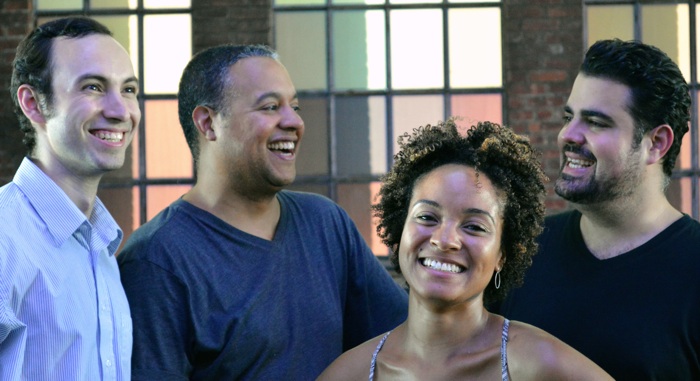Wow factor in Burlingame
Music at Kohl Mansion took note of their patrons’ wishes and brought back a popular group. On Sunday, April 17, the Harlem Quartet returned to a sold out house and played a concert that took on the emotional storms of the classical repertoire along with the joyous strutting of jazz. I last heard this quartet when they appeared here in March of 2011 and was delighted to see them return. Judging by the standing ovations, the audience was also enchanted.
Like that earlier concert, they warmed up with Beethoven, and it was young Beethoven with sprightly figures and warmth, and splashes of minor and even a Gypsy violin duel. That younger Beethoven was exquisitely “fresh,” and these four players gave it the bright-eyed clarity that it deserved. First violinist Ilmar Gavilan had a razor edge to his bow in the top register and killed it technically, but his bottom register was where the money notes were.
Second violinist Melissa White brought fierceness and warmth, fitting into the first violin part with timing that was jaw-dropping: in the last part of the concert they had to bow sixteenth notes with merciless timing. I asked her afterwards how incredible that passage was. She was happy that we noticed that bit of superhuman exertion in the Mendelssohn quartet, and added, “We spent extra time working that passage.”
Jaime Amador took the viola part, a role of two parts affection and one part passion, and that is the real glue that binds all string quartets. In his solos we were finally able to hear his blistering attacks and the fiery uniqueness of his voice. Crouching forward as he played, I was reminded of a mixed martial artist getting ready for a take down.
And their cellist is a relative newcomer. He has only joined this quartet a year ago but fits in like a glove. Neurasthenic and supple, his sound was lucid and dry in the upper register, a baritone with exceptionally clear high notes. But there were times when he did come all the way down to the bottom and grind out some of that gravel that makes a cello such a visceral instrument.
The first movement felt like a young man’s yearning in the springtime, written in the minor but too alive and magical to be truly tragic. Then the violins traded mincing notes while the cello and viola gave them lilt and gravitas. The Menuetto brought us back to the tenderness of spring, and the final Allegro was mad Gypsy fiddling at its finest. The young Beethoven wrote it because he apparently could, and Gavilan and White tore into it at an eye-popping clip… because they could!
But this was just a warm up. We next found out that the real strength of this quartet is that they can do for jazz what they did for classical. Cellist Felix Umansky introduced the next piece: “Dizzy Gillespie was the Beethoven of the jazz genre. Just like Beethoven was a game-changer, so was Dizzy. This is one of his better known tunes, arranged for the Harlem Quartet by Faith Glen.”
Umansky sat down and turned to pizzicato to mimic the bass line of a jazz ensemble. The higher strings leaned into slow chords that were sumptuous and jazzy, and then Gavilan worked out an insanely fast piece of virtuosity while alluding to the melody and beat. The viola followed, and Amador found deep be-bop roots here with an earthier version of the violin melody that compelled the audience to sway. The cello joined, and viola and cello were one manic instrument, doing something that seldom happens in jazz: a duet that was as inspired as a riff, and then they turned to White, who swayed into offbeat territory. But as she did her music blew off the stand. She closed her eyes and gave it some incendiary push, and we all knew that it was meant to be this way.
They next turned their classical attentions to “Girl from Ipanema” by Antonio Jobim. This was a slow and open weave, gently propelled with piquant chords.
But then they blew out the cobwebs with a scorching “El Cumbanchero,” arranged by Gavilan’s father, composer Guido Gavilan, for the Harlem Quartet. Umansky tapped out congas on the wooden top of his cello, and then gave us some of that grit – deep hefty notes that propelled the quartet into one display after another. White was particularly fierce here, followed by Gavilan.
After intermission they charged into the last quartet that Mendelssohn wrote, and one could hear in it his deep mourning of the death of his sister. There was nothing funereal about this. Quite the opposite: this was a raging at the fates, and was taken at a blistering pace and with an emotional immediacy that dragged us in tow.
“It is hard to smile after I have played that piece,” said cellist Umansky. “It was her requiem and the last piece he ever wrote.”
But after long ovations and several exits and entrances they did brighten the mood with an encore, their string version of Billy Strayhorn’s “Take the A Train,” which I heard them perform five years ago. And it was just as happily ironic. I heard audience members asking Music at Kohl Mansion director Patricia Kristof Moy to please bring them back every year!
—Adam Broner
Photo, below, of the Harlem Quartet by Amy Schroeder, from left: Felix Umansky, Ilmar Gavilan, Melissa White and Jaime Amador.

